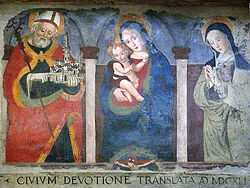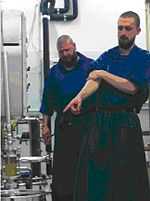Monastery of St. Benedict (Norcia)


The Benedictine Monks of Norcia (Italian: Monastero di San Benedetto di Norcia) are members of the Order of St. Benedict and are located in Norcia (formerly Nursia), Italy, in the extreme southeast tip of Umbria beneath the slopes of the Sibylline mountains. The current monastery is physically located above the 5th century ruins of the house of St. Benedict and his twin sister St. Scholastica, and has been the location of monastic communities since the tenth century AD. Today the Monks of Norcia care for the spiritual, pastoral, and temporal needs of approximately 50,000 pilgrims from around the world who annually visit the birthplace of Sts. Benedict and Scholastica.
History
In the 8th century an oratory was built so pilgrims could pray at the place of St. Benedict’s birth. Monks came to Norcia in the 10th century, and remained in one form or another until 1810, when they were forced to flee under the new laws of the Napoleonic Code. The current Benedictine community was founded in Rome on September 3, 1998, without being conditioned by previous historical circumstances. These original monks transferred from Rome to Norcia on December 2, 2000, in the great Jubilee Year, becoming The Benedictine Monks of Norcia. They were charged by Rome to care for the Basilica of San Benedetto (built over the birthplace of St Benedict and St Scholastica) and for the many visiting pilgrims. The Benedictines of Norcia see themselves as humble instruments for the necessary New Evangelization of Europe.[1] As of July 2011 there are nineteen monks living at Norcia, four of which are ordained priests and two novices.[2] The Benedictine Monastery of Norcia is also known as the Benedictine monastery Maria Sedes Sapientiae (“Mary Seat of Wisdom”). In February 2012 the Monastery was canonically established under the supervision of the Abbot Primate in the International Benedictine Confederation.
Charism
The charism of the Monks of Norcia is "to return to the spirit of the founder",[3] following the explicit appeal of the Vatican II document on Religious Life, Perfectae Caritatis. On April 21, 2009 the Holy See entrusted to the community the special liturgical apostolate of celebrating both authorized forms of the Roman Rite (in utroque usu - “according to both usages”): the Extraordinary and the Ordinary form.[4] This makes the Benedictine Monks of Norcia one of the few religious communities throughout the world that celebrates both forms of the Roman Rite (See Communities using the Tridentine Mass). The founding prior, Father Cassian Folsom, O.S.B. writes:
- "The history of the liturgy shows clearly a multiplicity of usages within the one Roman rite. It is thanks to many years of studying the liturgy that I came to see the importance of this unity in diversity. In fact, I argued this point in the presence of the then-Cardinal Ratzinger at a liturgical conference held at Fontgombault in France in 1997. As a liturgist, I would also like to say that there is no perfect rite; there are positive and negative aspects in every liturgical tradition. The only perfect liturgy is the heavenly one.... At the risk of oversimplifying, I would say that the ordinary form stresses rational understanding, speaking in prose, as it were. The extraordinary form provides rich food for the intellect also, but relies heavily on gesture, symbolism, intuition, silence, ritual action without words, speaking in poetry, you might say. Man knows both rationally and intuitively. He needs both prose and poetry. If the two usages, like two different cultures, can patiently live with each other over time, they can become friends."[5]
Coat of arms

The coat of arms of the monastery is divided into two sections. On the left hand side is the symbol of the Celestine monks who were present in Norcia before being suppressed by the Napoleonic laws of 1810, representing the continuity with the past. The Celestines were part of a widespread movement in the Church in the thirteenth century which emphasized the power of the Holy Spirit. Their symbol, therefore, is a large S, standing for Spiritus Sanctus.
The right side of the seal represents the present: a stump with new shoots of life growing from it. The stump represents monastic life violently cut off in 1810. The new shoots of life represent the present community, and the three leaves represents the three original monks who arrived in Norcia in 2000. As the prophet Isaiah says: "There shall come forth a shoot from the stump of Jesse, and a branch shall grow out of his roots" (Isaiah 11:1). This image has always been a sign of hope.
Birra Nursia


Early in 2012 the Monks of Norcia established a brewery in an renovated warehouse. They hosted a grand opening celebration on August 15, 2012 - the Solemnity of the Assumption of the Blessed Virgin Mary.[6] The name for the beer is “Birra Nursia”, which uses the Latin name for the city of Norcia. The motto of the brewery is taken from the Psalms: “ut laetificet cor” (that the heart might be gladdened). In complete harmony with the centuries old tradition, the monks of Norcia have sought to share with the world a product which came about in the very heart of the monastic life, one which reminds us of the goodness of creation and the potential that it contains.
Fr. Cassian writes that the monks chose to name the beer after the city for two reasons:
- "First, it is where St. Benedict himself was born and to whom we owe our gratitude and veneration as the founder. Secondly, it is the city of Norcia which opened its arms widely to us in the year 2000 when the monastery was given to us. The beer is made by monks, yes; but it is a thanks to the townspeople and so many of you that we have been able to sustain ourselves in these initial pioneer years. We hope to give back to you with our beer, what we have so generously received from your open hands. May God continue to bless you and your families... As is customary for monastic breweries, the name of the beer is connected to the city. For instance, Chimay and Orval are both towns in Belgium which have monastic breweries. Therefore, our monastery will do something similar, using the Latin word: “Nursia”, and calling it “Birra Nursia”. "[7]
Norcia is famous for wild boar, cheese, and prosciutto, not to mention truffles and being the birthplace of SS Benedict and Scholastica. To that list, the monks are producing a high quality brew that is an excellent accompaniment to the boar, cheese, and prosciutto. Many of the shops, hotels, and restaurants in town have begun selling Birra Nursia to their customers, and many supporters of the Monks of Norcia in the United States eagerly await for their beer to be imported.
His Eminence George Cardinal Pell blessed the brewery equipment in 2014, and called the Birra Nursia Brewery an “example of the new evangelization.”[8] More recently, the rise of monastic breweries has been termed the “Brew Evangeliztion”.[9]
In keeping with the strict enclosure required by the Rule of St Benedict, the public has very limited access to the brewery. Tours are offered once a year, on the anniversary of the brewery opening, August 15th, and includes a tasting session of recent brews. No reservation is required for the yearly tour.
In popular culture

The Monks of Norcia made headlines by supplying Birra Nursia to all the cardinals of the papal conclave that elected Pope Francis I.[10][11] Fr. Benedict Nivakoff, O.S.B. explained:
- "Birra Nursia even participated in the election of Pope Francis. Several cases of beer were given to the cardinals before the start of the conclave. The fact that the Pope chose “Francis” as a name, and our master brewer is our own Br. Francis Davoren (from Texas!) does not seem to us a coincidence! Perhaps those initial smiles from the Loggia of St. Peter’s were the fruit not just of the Holy Spirit, but of our very own motto, Ut Laetificet Cor!"[12]
Thus it is speculated that the Monks of Norcia were responsible for the naming of the last two popes; Cardinal Ratzinger visited the monastery for the Feast of St. Benedict in 2003, shortly before becoming pope and choosing the name Benedict XVI. This name was chosen in part because of his experience at Norcia and other Benedictine monastic communities.
References
- ↑ Die Tagespost , Werkzeug der Neuevangelisierung, July 20th, 2011.
- ↑ Die Tagespost , Werkzeug der Neuevangelisierung, July 20th, 2011.
- ↑ Perfectae Caritatis , Decree on the Adaptation and Renewal of Religious Life, proclaimed by His Holiness Pope Paul VI on October 28, 1965.
- ↑ In this way the monastery takes to heart the words of Benedict XVI that there should be a mutual enrichment of the Ordinary and Extraordinary Forms of the Roman Rite: "The two Forms of the usage of the Roman Rite can be mutually enriching... What earlier generations held as sacred, remains sacred and great for us too, and it cannot be all of a sudden entirely forbidden or even considered harmful. It behooves all of us to preserve the riches which have developed in the Church's faith and prayer, and to give them their proper place." (Pope Benedict XVI, Letter to Bishops, 7 July 2007 ).
- ↑ The Moynihan Report, Top Ten People of 2011 by Inside the Vatican magazine, January 10, 2012 .
- ↑ Birra Nursia Website .
- ↑ The Monks of Norcia Summer 2012 Newsletter .
- ↑ Birra Nursia: “An Example of the New Evangelization” .
- ↑ "Brew Evangelization: The Ongoing Renaissance of Monastic Beer" ["http://www.catholicworldreport.com/Item/3651/brew_evangelization_the_ongoing_renaissance_of_monastic_beer.aspx]
- ↑ Monks in the News .
- ↑ Blog post: Do you know what helps select a Good Pope? A good beer..
- ↑ The Monks of Norcia Summer 2013 Newsletter .
See also
Communities using the Tridentine Mass.
External links
| Wikimedia Commons has media related to Monastery of San Benedetto in Norcia. |
| ||||||||||||||||||||||||||||||||||||||||||||||||||||||||||||
